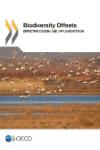Biodiversity, water and natural resource management
Publications on biodiversity
 |
OECD publications on biodiversity draw on insights and experiences from a range of countries to develop good practices on various issues. These include, among others, the effective design and implementation of policy instruments to promote biodiversity conservation and sustainable use, how to mainstream biodiversity across sectors and policy areas, scaling up finance for biodiversity, and biodiversity outlooks. |
|
Mainstreaming Biodiversity into Renewable Power Infrastructure As countries scale up climate action, they face the challenge of expanding renewable power while tackling biodiversity loss. Transitioning away from fossil fuels can reduce climate-related pressure on biodiversity, but brings its own risks. Unless carefully managed, the expansion of renewable power could compromise biodiversity. This report synthesises evidence on biodiversity impacts from renewable power infrastructure, with a focus on solar power, wind power and power lines. It identifies opportunities for mainstreaming biodiversity into power sector planning and policy to deliver better outcomes for nature and the climate. Drawing on good practice insights from across the globe, the report offers governments recommendations to align renewable power expansion with biodiversity goals. |
 |
|
Towards Sustainable Land Use: Aligning Biodiversity, Climate and Food Policies, 2020 Land use is central to many of the environmental and socio-economic issues facing society today. This report examines on-going challenges for aligning land-use policy with climate, biodiversity and food objectives, and the opportunities to enhance the sustainability of land-use systems. It looks at six countries – Brazil, France, Indonesia, Ireland, Mexico and New Zealand – with relatively large agricultural and forestry sectors and associated greenhouse gas emissions, many of which also host globally important biodiversity. Drawing on these countries’ relevant national strategies and plans, institutional co-ordination and policy instruments, the report provides good practice insights on how to better align land use decision-making processes and to achieve stronger coherence between land use, climate, ecosystems and food objectives. |
 |
|
Biodiversity: Finance and the Economic and Business Case for Action, 2019 The Convention on Biological Diversity’s 15th Conference of the Parties (CBD COP15) in 2020 marks a critical juncture for one of the defining global challenges of our time: the loss of biodiversity and ecosystem services, which underpin nearly all of the Sustainable Development Goals (SDGs). Transformative changes are needed to ensure biodiversity conservation and sustainable use and the delivery of the ecosystem services upon which all life depends. This report sets the economic and business case for urgent and ambitious action on biodiversity. It presents a preliminary assessment of current biodiversity-related finance flows, and discusses the key data and indicator gaps that need to be addressed to underpin effective monitoring of both the pressures on biodiversity and the actions (i.e. responses) being implemented. The report concludes with ten priority areas where G7 and other countries can prioritise their efforts. |
 |
|
Mainstreaming Biodiversity for Sustainable Development, 2018 |
|
|
Marine Protected Areas: Economics, Management and Effective Policy Mixes, 2017 Intense exploitation of our oceans and seas is degrading marine biodiversity and ecosystems at an alarming rate. This report presents good practice insights for effectively managing marine protected areas (MPAs), one of the policy instruments available for the conservation and sustainable use of marine biodiversity and ecosystems. While global coverage of MPAs has been increasing over the past two decades, further efforts are required to meet the target under the Sustainable Development Goals and to ensure they are effective. |
|
|
The Political Economy of Biodiversity Policy Reform, 2017 This report provides insights on the political economy of biodiversity-related reforms. It draws on existing literature and four new case studies covering the French tax on pesticides, agricultural subsidy reform in Switzerland, EU payments to Mauritania and Guinea Bissau to finance marine protected areas, and individually transferable quotas for fisheries in Iceland. Each case study focuses on the drivers for reform, the types of obstacles encountered, key features of the policy reform, and the lessons learned from the reform experience. |
 |
|
Biodiversity Offsets: Effective Design and Implementation, 2016 This book examines the opportunities and challenges associated with biodiversity offset programmes and provides policy makers and practitioners with good practice insights on their design and implementation so as to ensure more effective outcomes. It draws on lessons and insights from more than 40 case studies worldwide and three in-depth reviews from the United States, Germany and Mexico. |
 |
|
Scaling up Finance Mechanisms for Biodiversity, 2013 This report examines six mechanisms that can be used to scale-up financing for biodiversity conservation and sustainable use and to help meet the 2011-20 Aichi Biodiversity Targets. The mechanisms are environmental fiscal reform, payments for ecosystem services, biodiversity offsets, green markets, biodiversity in climate change funding, and biodiversity in international development finance. Drawing on literature and more than 40 case studies worldwide, this book addresses the following questions: What are these mechanisms and how do they work? How much finance have they mobilised and what potential is there to scale this up? And what are the key design and implementation issues that need to be addressed so that governments can ensure these mechanisms are environmentally effective, economically efficient and distributionally equitable? |
|
|
, 2012 Humanity has witnessed unprecedented growth and prosperity in the past decades, with the size of the world economy more than tripling and population increasing by over 3 billion people since 1970. This growth, however, has been accompanied by environmental pollution and natural resource depletion. The current growth model and the mismanagement of natural assets could ultimately undermine human development. The report asks "What will the next four decades bring?" Based on joint modelling by the OECD and the Netherlands Environmental Assessment Agency, it looks forward to the year 2050 to find out what demographic and economic trends might mean for the environment if the world does not adopt more ambitious green policies. This report identified biodiversity as one of the four critical priorities for the coming two decades. The Environmental Outlook predicts that without renewed efforts to halt the loss of biodiversity, a further 10 percent of biodiversity (measured in Mean Species Abundance) will be lost by 2050. Read the Biodiversity chapter.
|
 |
|
Paying for Biodiversity: Enhancing the Cost-Effectiveness of Payments for Ecosystem Services, 2010 This book identifies good practice in the design and implementation of PES programmes to enhance their environmental and cost effectiveness. It addresses the following questions: Why are PES useful and how do they work? How can they be made most effective environmentally and how can their cost-effectiveness be maximised? What are the different potential sources of finance for PES programmes, and how can they be secured? What are the lessons learned from existing PES programmes and insights for future programmes, including international PES? |
|
|
People and Biodiversity Policies: Impacts, Issues and Strategies for Policy Action, 2008 Biodiversity policies promote the protection, conservation, and sustainable use of biologically diverse ecosystems and habitats. In doing so, they create significant public benefits and contribute to social well-being. However, the implementation of biodiversity policies will often benefit different groups to a greater or lesser degree. At times, some groups in society lose out under certain policies. For example, in establishing a property right to facilitate management of a biodiversity-related resource, people who previously had unrestricted use will be adversely affected. |
|
|
Handbook of Market Creation for Biodiversity: Issues and Implementation, 2004 This book shows how public policy in the form of market creation can be used to internalise the loss of biodiversity. It promotes the use of markets to ensure that our collective preferences for conversation and sustainable use are reflected in economic outcomes. Striking the right balance between the conservation/sustainable use and the loss of biodiversity requires accounting for all the impacts of its destruction. Weighing the loss against any potential benefits will ensure that the social, as well as economic, well-being of everyone are at the best levels possible. Market-based economic systems have the potential to ensure that such a balancing occurs, but require that all the impacts of its loss, or use, have been fully internalised into market transactions. |
|
|
Harnessing Markets for Biodiversity: Towards Conservation and Sustainable Use, 2003 The private provision of biodiversity products and services is proving to be quite feasible in some circumstances. Some biodiversity products and services are already being profitably marketed. Private markets also need to be supported by appropriate public policies. This publication provides a conceptual framework for market creation in the biodiversity policy arena, as well as several examples of where the use of markets can assist policy makers in the search for more sustainable use and conservation of biodiversity. |
|
|
Handbook of Biodiversity Valuation: A Guide for Policy Makers, 2002 This Handbook describes the types of values usually associated with biodiversity. While there are exceptions to the need to prioritise economic values over other cultural, traditional and spiritual values, economic valuation has a sound theoretical foundation that can help clarify the tradeoffs implicit in public policy decisions. On the other hand, the Handbook recognises the limitations of the economic approach, and considers how economic and non-economic values can eventually be reconciled.
|
|
|
Valuation of Biodiversity Benefits: Selected Studies, 2001 This Handbook describes the types of values usually associated with biodiversity. While there are exceptions to the need to prioritise economic values over other cultural, traditional and spiritual values, economic valuation has a sound theoretical foundation that can help clarify the tradeoffs implicit in public policy decisions. On the other hand, the Handbook recognises the limitations of the economic approach, and considers how economic and non-economic values can eventually be reconciled. |
|
|
Handbook of Incentive Measures for Biodiversity: Design and Implementation, 1999 This Handbook draws on the experiences described in 22 case studies to develop a comprehensive step-by-step process for identifying and implementing appropriate incentive measures for biodiversity conservation, and the sustainable use of its components. It identifies the incentive measures that are most suitable for particular ecosystems, and for addressing the specific sectoral pressures in effect, describing both the advantages and the disadvantages of each incentive measure. A wide range of incentive measures are described, including both the more common economic and regulatory incentives, and also the necessary framework conditions, such as scientific and technical capacity building, education and awareness raising, and the involvement of local populations and other stakeholders. |
FURTHER READING
- OECD Environment Working Papers on biodiversity
- OECD Environment Working Papers and Environment Policy Papers
- Economics and policies for biodiversity: OECD's response
Related Documents









